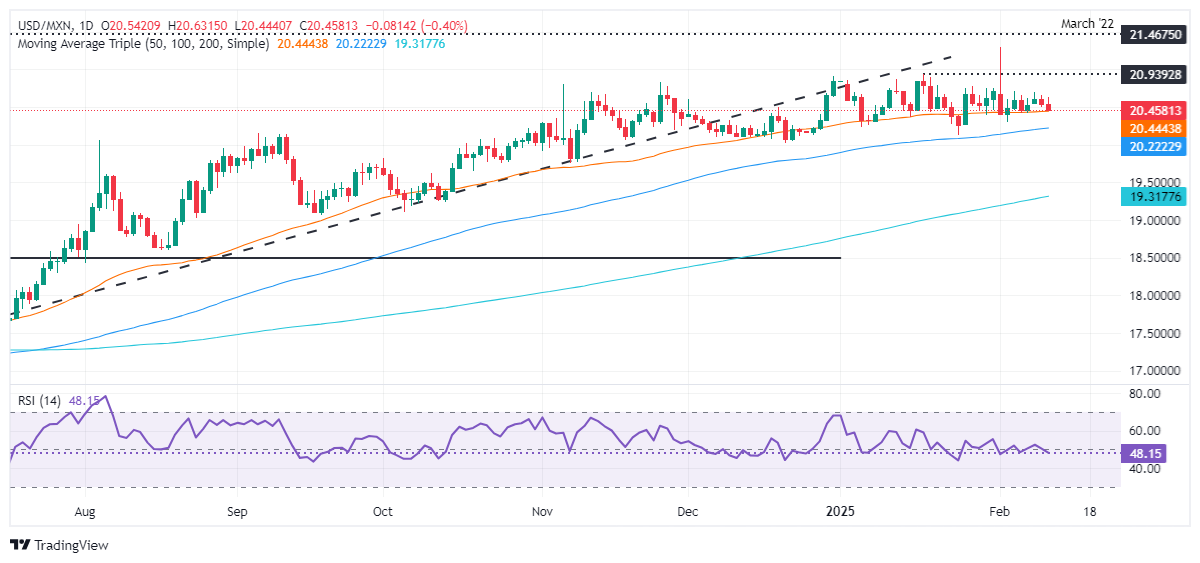Mexican Peso defies US inflation shock, extends gains
- Mexican Peso shrugs off hot US inflation, Fed’s rate-cut hopes dwindle
- US inflation jumps past 3%, delaying Fed rate-cut expectations until September.
- Fed Chair Powell signals restrictive policy will persist as core prices remain strong.
- MXN gains despite lack of local economic data; Mexico-US steel tariff talks ahead.
The Mexican Peso (MXN) extended its gains against the US Dollar (USD) for the second consecutive day, unfazed by the jump in inflation in the United States (US), preventing the Federal Reserve (Fed) from easing policy. The USD/MXN pair trades at 20.51, down 0.14%.
The Consumer Price Index (CPI) in January jumped above the 3% YoY threshold for the first time in six months, indicating that the Fed’s job of tackling inflation is not done, as shown by US Bureau of Labor Statistics (BLS) data. Core prices also increased, justifying the Fed’s decision to hold rates at the January meeting.
After the US CPI release, the swaps market speculated that the Fed would not cut rates until the September meeting. December’s fed funds rate futures contract shows the market is pricing 29.5 basis points (bps) of easing towards the end of the year.
Meanwhile, Fed Chair Jerome Powell testified against the US House of Representatives. He commented that core prices remain strong and that the Fed must wait to see monetary policy's effects. Powell acknowledged that the job on inflation was not done and wanted to keep policy restrictive.
The economic docket remains absent in Mexico, yet President Claudia Sheinbaum said that Mexico and the US will discuss steel tariffs later this week. In the US, the schedule will feature the release of the Producer Price Index (PPI), Initial Jobless Claims, Retail Sales, and Industrial Production.
Daily digest market movers: Mexican Peso ignores US inflation data
- Mexico’s economic docket remains absent, yet deterioration in the automobile industry and worse-than-expected Industrial Production figures hint the economy is in worse shape than expected.
- This and US President Donald Trump's trade rhetoric on Mexico would be headwinds for the Mexican currency.
- The Consumer Price Index (CPI) surpassed 3% YoY for the first time since June 2024, with the month-over-month (MoM) figures increasing by 0.5%, up from December's 0.4%.
- Excluding volatile items, the core CPI rose by 3.3% YoY from 3.2%, and monthly, it expanded by 0.4%, an increase from the previous 0.2% and exceeding the estimated 0.3%.
- Trade disputes between the US and Mexico remain in the boiler room. Although the countries found common ground previously, USD/MXN traders should know that there is a 30-day pause and that tensions could arise toward the end of February.
- Money market fed funds rate futures are pricing in 28.5 basis points (bps) of easing by the Fed in 2025.
USD/MXN technical outlook: Mexican Peso consolidates, awaiting fresh catalyst
USD/MXN has fallen toward the 50-day Simple Moving Average (SMA) at 20.46, which, if broken, could pave the way for a retracement. Price action suggests the exotic pair has consolidated near the 20.40 – 20.68 area during the last five days, with momentum slightly tilted to the downside as the Relative Strength Index (RSI) turned bearish.
A drop of USD/MXN below 20.40 would favor a test of the 100-day SMA at 20.22, exposing the critical 20.00 figure. If surpassed, the exotic pair could aim toward 19.50 and eye a test of the 200-day SMA at 19.26.
In the meantime, if buyers clear 20.68, the next resistance would be the January 17 high at 20.90. Once surpassed, the next stop would be 21.00, followed by the year-to-date (YTD) at 21.29.

Mexican Peso FAQs
The Mexican Peso (MXN) is the most traded currency among its Latin American peers. Its value is broadly determined by the performance of the Mexican economy, the country’s central bank’s policy, the amount of foreign investment in the country and even the levels of remittances sent by Mexicans who live abroad, particularly in the United States. Geopolitical trends can also move MXN: for example, the process of nearshoring – or the decision by some firms to relocate manufacturing capacity and supply chains closer to their home countries – is also seen as a catalyst for the Mexican currency as the country is considered a key manufacturing hub in the American continent. Another catalyst for MXN is Oil prices as Mexico is a key exporter of the commodity.
The main objective of Mexico’s central bank, also known as Banxico, is to maintain inflation at low and stable levels (at or close to its target of 3%, the midpoint in a tolerance band of between 2% and 4%). To this end, the bank sets an appropriate level of interest rates. When inflation is too high, Banxico will attempt to tame it by raising interest rates, making it more expensive for households and businesses to borrow money, thus cooling demand and the overall economy. Higher interest rates are generally positive for the Mexican Peso (MXN) as they lead to higher yields, making the country a more attractive place for investors. On the contrary, lower interest rates tend to weaken MXN.
Macroeconomic data releases are key to assess the state of the economy and can have an impact on the Mexican Peso (MXN) valuation. A strong Mexican economy, based on high economic growth, low unemployment and high confidence is good for MXN. Not only does it attract more foreign investment but it may encourage the Bank of Mexico (Banxico) to increase interest rates, particularly if this strength comes together with elevated inflation. However, if economic data is weak, MXN is likely to depreciate.
As an emerging-market currency, the Mexican Peso (MXN) tends to strive during risk-on periods, or when investors perceive that broader market risks are low and thus are eager to engage with investments that carry a higher risk. Conversely, MXN tends to weaken at times of market turbulence or economic uncertainty as investors tend to sell higher-risk assets and flee to the more-stable safe havens.

